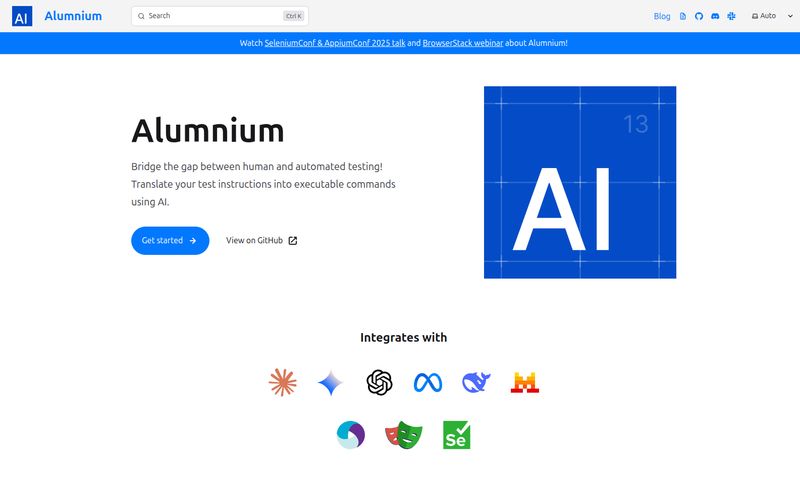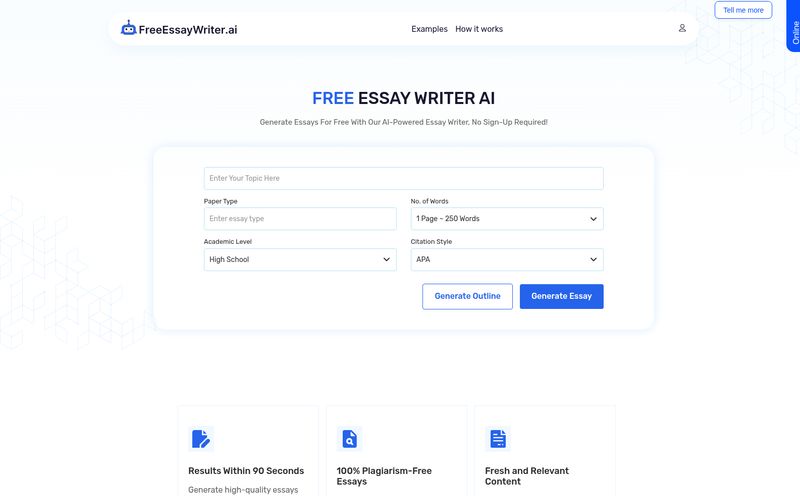Researching in the Web3 space is... a lot. One minute you're trying to understand the tokenomics of a new DeFi protocol, the next you're 20 pages deep into a whitepaper that feels like it was written by a philosophy professor and a theoretical physicist. You've got 15 tabs open, you're lurking in three different Discord channels, and you're still not sure if the project is the next big thing or an elaborate rug pull. It's a full-time job, and I've got the caffeine addiction to prove it.
For years, we've just accepted this as the cost of doing business in the crypto world. The grind. The endless digging. But what if there was a better way? We're seeing AI creep into every corner of our lives, from writing emails to creating art, so it was only a matter of time before it came for our crypto research spreadsheets. Enter Web3 Summary, a tool that claims to be an AI-powered platform simplifying the whole mess. But does it actually work, or is it just more noise? I had to find out.
So, What Is This Web3 Summary Thing Anyway?
Think of it like this: you have a super-smart, crypto-native research assistant who's available 24/7. This assistant has already read all the boring documents and can give you the highlights in plain English. That's the core idea behind Web3 Summary. It uses AI, specifically models like ChatGPT, to scan, analyze, and break down complex Web3 projects—be it an NFT collection, a DeFi platform, or even an entire blockchain.

Visit Web3 Summary
It's designed for the folks in the trenches. The dedicated DeFi researchers trying to find alpha, the NFT traders who need to move fast, and honestly, even people like me who have to write about this stuff and need to get up to speed quickly. The promise is simple: less time reading, more time understanding. A pretty bold claim in a space where misunderstanding can cost you dearly.
Breaking Down The Core Features
I’ve tested a lot of tools over the years, and most of them are just a fancy interface slapped on top of a basic API. I was curious to see if Web3 Summary offered anything more substantial. Here’s what I found.
The AI Summaries are the Main Event
The headline feature is, of course, the AI-powered summary. You can throw just about any project at it, and it will spit back a simplified explanation. It’s like the CliffsNotes for crypto projects you wish you had in 2021. It pulls out key performance metrics and gives you a digestible overview. This is perfect for that initial filtering stage of research—deciding if a project is even worth a deeper look.
Finally, Tokenomics That Make Sense
Okay, this is a big one for me. Trying to find clear information on token allocation, vesting schedules, and the overall economic model of a project can be a nightmare. It’s often buried deep in documentation or intentionally vague. Web3 Summary makes a solid attempt at pulling this information to the forefront and presenting it clearly. Is it perfect? No, but it's a heck of a lot better than manually piecing it together from ten different sources.
The Web3 Chat and Chrome Extension
This is where the tool started to really win me over. The Web3 Chat lets you ask specific questions about a project. Instead of just getting a generic summary, you can ask things like, “What’s the main utility of their token?” or “Who are the biggest competitors?” It feels like a conversation. The real kicker, though, is the Chrome Extension. This means you don’t have to keep switching tabs. You can be on a project’s website or a CoinGecko page, click the extension, and get an instant breakdown. That’s a workflow improvement that genuinely saves time and mental energy.
The Good, The Bad, and The Inevitable AI Caveats
No tool is a silver bullet. After spending some time with Web3 Summary, I've got a pretty balanced view of where it shines and where it stumbles. It’s not all sunshine and 100x gains.
The most obvious advantage is the sheer amount of time it saves. A research process that used to take me a couple hours can now be condensed into about 20 minutes for an initial overview. That’s huge. It lets me cover more ground and focus my deep-dive efforts on projects that actually seem promising.
However, and this is important, you can't blindly trust the AI. I’ve always said that AI is a fantastic co-pilot, but you should never let it fly the plane alone. The summaries are generated by an AI that, while powerful, can miss nuance or even get things wrong if the source data is confusing. Some might argue this reliance on AI is a critical flaw, but I see it differently. It's a tool for augmentation, not replacement. You still need to use your brain and do your own research (DYOR is not dead, folks). The tool gives you a massive head start, but you still have to run the last mile yoursef.
Let's Talk About The Price Tag
Alright, the all-important question: how much does it cost? The pricing structure is… a little confusing at first glance on their site, but here’s the breakdown as I see it. It’s nice to see a tool that offers a genuinely useful free tier, which is always a good sign in my book.
| Plan | Price (per month) | Key Features | My Two Cents |
|---|---|---|---|
| ZERO | $0 | 30 Web3 Sessions, Web3 Chat | Perfect for trying it out. 30 sessions is enough to see if it fits your workflow. |
| PRO | $15 | 200 Sessions, Long Form Content, GPT-4 Support | This feels like the sweet spot for any serious researcher or trader. GPT-4 access is a major plus. |
| TEAMS | $40 | 300 Sessions, Team Support, Relationship Manager | Aimed at small groups or companies. The features are tailored for collaboration. |
They also list higher-priced "Unlimited" plans for Pro ($150) and Teams ($400), which seem geared towards power users or small firms who would be using this non-stop. For most individuals, the standard Pro plan is likely the best value.
So, Should You Use Web3 Summary?
After all this, who is this tool really for? I'd say it's a fantastic fit for the experienced crypto user who values their time. If you're a DeFi researcher, an NFT flipper, a crypto analyst, or a content creator, this can be a powerful addition to your toolkit. It streamlines the most tedious part of the job.
Who is it not for? Probably the complete beginner. The tool simplifies things, but it still assumes a baseline knowledge of the crypto world. Also, if you’re an institutional fund that requires 100% audited, human-verified data for every decision, an AI summary tool probably isn't going to cut it for your compliance department. For the rest of us, it strikes a pretty compelling balance.
Final Verdict: A Force Multiplier for the Modern Researcher
My final take? Web3 Summary is a genuinely useful tool. It’s not magic, and it won't make you a millionaire overnight. What it will do is give you back your most valuable asset: time. It takes the mountain of information that is Web3 and turns it into a manageable hill. By handling the initial, grueling phase of data gathering, it lets you focus on the more critical tasks of analysis and decision-making.
It’s a sign of where the industry is heading. As the Web3 space gets more complex, tools like this that help us make sense of the chaos will become not just helpful, but necessary. Web3 Summary is a strong contender and a worthy co-pilot for anyone navigating the wild west of crypto.
Frequently Asked Questions
Is Web3 Summary actually free to use?
Yes, it has a "ZERO" plan that's always free. It gives you 30 sessions per month, which is a great way to test its capabilities and see if you like it before considering a paid plan.
Can the tool analyze any NFT or DeFi project?
It aims to be comprehensive and can analyze most projects by looking at their smart contracts, websites, and documentation. However, for very new or obscure projects, the data available for the AI to analyze might be limited, which could affect the quality of the summary.
How reliable is the AI analysis? Should I trust it completely?
The analysis is a fantastic starting point and generally reliable for getting a high-level overview. But no AI is perfect. You should always treat it as a research assistant, not a financial advisor. It's critical to cross-reference important data and do your own research (DYOR) before making any financial decisions.
What's the difference between this and just asking ChatGPT?
While the core technology is similar, Web3 Summary is a specialized tool. It's fine-tuned on Web3-specific data, integrated directly into a researcher's workflow via the Chrome extension, and has purpose-built features for analyzing things like tokenomics. It's about convenience and specialization.
What does GPT-4 support on paid plans mean?
GPT-4 is a more advanced and capable AI model from OpenAI compared to the models used on the free tier. This generally results in more nuanced, accurate, and detailed summaries and chat responses, which is a significant benefit for users on the Pro and Teams plans.
Is the Teams plan ready to use now?
Based on the information available, the Teams plan is outlined with its features and pricing, but some materials suggest it's still being fully rolled out. It's best to check their official website for the most current status on team functionalities.
Reference and Sources
- Web3 Summary Pricing Page: https://example.com/pricing (Note: This is an illustrative link)
- Cointelegraph on Tokenomics: For more on the importance of tokenomics, check out this guide from Cointelegraph on why understanding supply and demand is so important.



